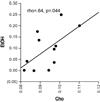Brain injury and recovery following binge ethanol: evidence from in vivo magnetic resonance spectroscopy
- PMID: 20044076
- PMCID: PMC2854208
- DOI: 10.1016/j.biopsych.2009.10.028
Brain injury and recovery following binge ethanol: evidence from in vivo magnetic resonance spectroscopy
Abstract
Background: The binge-drinking model in rodents using intragastric injections of ethanol (EtOH) for 4 days results in argyrophilic corticolimbic tissue classically interpreted as indicating irreversible neuronal degeneration. However, recent findings suggest that acquired argyrophilia can also identify injured neurons that have the potential to recover. The current in vivo magnetic resonance (MR) imaging and spectroscopy study was conducted to test the hypothesis that binge EtOH exposure would injure but not cause the death of neurons as previously ascertained postmortem.
Methods: After baseline MR scanning, 11 of 19 rats received a loading dose of 5 g/kg EtOH via oral gavage, then a maximum of 3 g/kg every 8 hours for 4 days, for a total average cumulative EtOH dose of 43 +/- 1.2 g/kg and average blood alcohol levels of 258 +/- 12 mg/dL. All animals were scanned after 4 days of gavage (post-gavage scan) with EtOH (EtOH group) or dextrose (control [Con] group) and again after 7 days of abstinence from EtOH (recovery scan).
Results: Tissue shrinkage at the post-gavage scan was reflected by significantly increased lateral ventricular volume in the EtOH group compared with the Con group. At the post-gavage scan, the EtOH group had lower dorsal hippocampal N-acetylaspartate and total creatine and higher choline-containing compounds than the Con group. At the recovery scan, neither ventricular volume nor metabolite levels differentiated the groups.
Conclusions: Rapid recovery of ventricular volume and metabolite levels with removal of the causative agent argues for transient rather than permanent effects of a single EtOH binge episode in rats.
Copyright 2010 Society of Biological Psychiatry. Published by Elsevier Inc. All rights reserved.
Conflict of interest statement
The authors report no biomedical financial interests or potential conflicts of interest.
Figures





Similar articles
-
Rat strain differences in brain structure and neurochemistry in response to binge alcohol.Psychopharmacology (Berl). 2014 Jan;231(2):429-45. doi: 10.1007/s00213-013-3253-z. Epub 2013 Sep 13. Psychopharmacology (Berl). 2014. PMID: 24030467 Free PMC article.
-
Transient CNS responses to repeated binge ethanol treatment.Addict Biol. 2016 Nov;21(6):1199-1216. doi: 10.1111/adb.12290. Epub 2015 Aug 18. Addict Biol. 2016. PMID: 26283309 Free PMC article.
-
Jacobian Mapping Reveals Converging Brain Substrates of Disruption and Repair in Response to Ethanol Exposure and Abstinence in 2 Strains of Rats.Alcohol Clin Exp Res. 2021 Jan;45(1):92-104. doi: 10.1111/acer.14496. Epub 2020 Nov 20. Alcohol Clin Exp Res. 2021. PMID: 33119896 Free PMC article.
-
Association of alcohol in brain injury, headaches, and stroke with brain-tissue and serum levels of ionized magnesium: a review of recent findings and mechanisms of action.Alcohol. 1999 Oct;19(2):119-30. doi: 10.1016/s0741-8329(99)00025-7. Alcohol. 1999. PMID: 10548155 Review.
-
N-acetylaspartate as a marker of neuronal injury in neurodegenerative disease.Adv Exp Med Biol. 2006;576:241-62; discussion 361-3. doi: 10.1007/0-387-30172-0_17. Adv Exp Med Biol. 2006. PMID: 16802717 Free PMC article. Review. No abstract available.
Cited by
-
Hippocampal ceRNA networks from chronic intermittent ethanol vapor-exposed male mice and functional analysis of top-ranked lncRNA genes for ethanol drinking phenotypes.Adv Drug Alcohol Res. 2022;2:10831. doi: 10.3389/adar.2022.10831. Epub 2022 Dec 5. Adv Drug Alcohol Res. 2022. PMID: 36908580 Free PMC article.
-
Rat strain differences in brain structure and neurochemistry in response to binge alcohol.Psychopharmacology (Berl). 2014 Jan;231(2):429-45. doi: 10.1007/s00213-013-3253-z. Epub 2013 Sep 13. Psychopharmacology (Berl). 2014. PMID: 24030467 Free PMC article.
-
Ceramide metabolism analysis in a model of binge drinking reveals both neuroprotective and toxic effects of ethanol.J Neurochem. 2014 Dec;131(5):645-54. doi: 10.1111/jnc.12834. Epub 2014 Aug 21. J Neurochem. 2014. PMID: 25060779 Free PMC article.
-
Intravenous ethanol infusion decreases human cortical γ-aminobutyric acid and N-acetylaspartate as measured with proton magnetic resonance spectroscopy at 4 tesla.Biol Psychiatry. 2012 Feb 1;71(3):239-46. doi: 10.1016/j.biopsych.2011.06.026. Epub 2011 Aug 19. Biol Psychiatry. 2012. PMID: 21855054 Free PMC article. Clinical Trial.
-
A mechanism of rapidly reversible cerebral ventricular enlargement independent of tissue atrophy.Neuropsychopharmacology. 2013 May;38(6):1121-9. doi: 10.1038/npp.2013.11. Epub 2013 Jan 10. Neuropsychopharmacology. 2013. PMID: 23306181 Free PMC article.
References
-
- Sullivan EV, Pfefferbaum A. Neurocircuitry in alcoholism: A substrate of disruption and repair. Psychopharmacology (Berl) 2005;180:583–594. - PubMed
-
- Sullivan EV. Compromised pontocerebellar and cerebellothalamocortical systems: speculations on their contributions to cognitive and motor impairment in nonamnesic alcoholism. Alcoholism, clinical and experimental research. 2003;27:1409–1419. - PubMed
-
- Pfefferbaum A, Sullivan EV, Mathalon DH, Shear PK, Rosenbloom MJ, Lim KO. Longitudinal changes in magnetic resonance imaging brain volumes in abstinent and relapsed alcoholics. Alcoholism: Clinical and Experimental Research. 1995;19:1177–1191. - PubMed
Publication types
MeSH terms
Substances
Grants and funding
LinkOut - more resources
Full Text Sources
Medical

